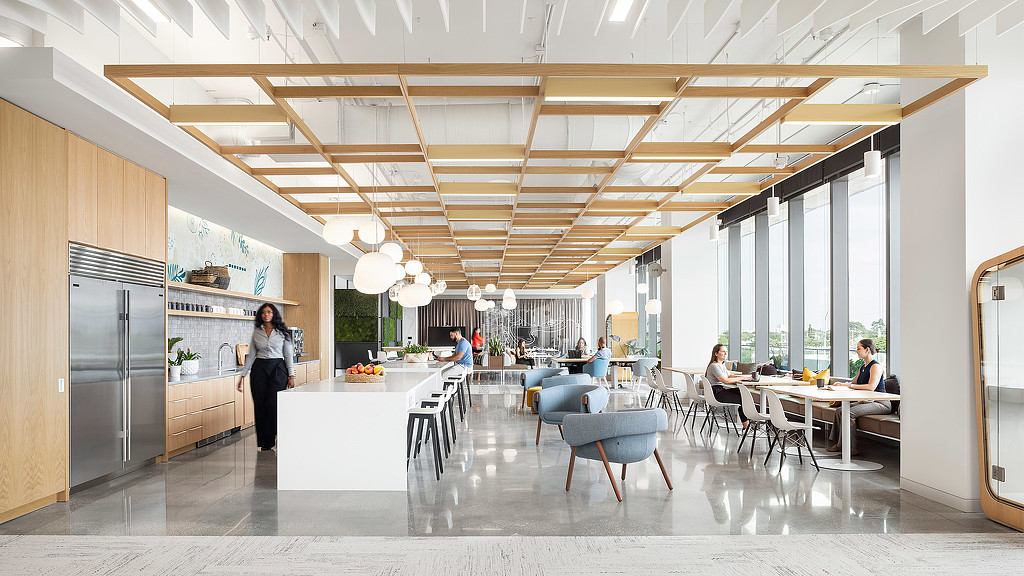How to Make Your Office an Experience Multiplier
May 17, 2022 | By Andy Cohen
Editor's Note: This piece was originally published on Forbes Business Council.
As the world strives to redefine the workplace in the post-pandemic era, leaders are considering how to encourage excitement for a return to the office and what that return should look like.
Virtual collaboration tools now allow knowledge workers to complete their tasks from home and so-called “third places.” Nitin Nohria in The Wall Street Journal recently suggested that “if the primary purpose of an office today is no longer to get actual work done, then perhaps it’s better conceived … as a place for connection and connectivity — as a clubhouse rather than a workplace.”
Against the backdrop of remote work that has filled the headlines, new research from the Gensler Research Institute (a part of our firm) finds that workers who are beginning to spend time in the office again have compelling reasons for making an effort to get there. They are coming back to access specific spaces, materials or resources that only the office can provide. They are coming back to meet with clients. They are coming back to maximize their personal productivity. And they are coming back to build professional relationships and make friends with co-workers.
Beyond the practicalities, there are other powerful motivations based on people’s desire for authentic experiences rather than virtual exchanges across the ether. So, rather than scale back the purpose of offices to focus on a single type of experience, I believe offices must offer twice the experience they did before the onset of the pandemic. The new office must be an experience multiplier, a destination rather than an obligation for workers who crave authentic engagement and interaction.
But how do you create that kind of place? Here are six strategies to make it happen.
1. Create team-based neighborhoods.
Workplaces should move away from the idea of a one-size-fits-all seating strategy. Now teams can be assigned to “neighborhoods” that contain an assortment of work settings. Some spaces might support individual focus and privacy, while others are better suited to small-group collaboration and brainstorming.
2. Leverage in-between spaces for flexibility and culture building.
In offices that are big enough to contain several neighborhoods, pay attention to the transition points where the neighborhoods intersect. These are ideal places to fulfill a host of needs: storage, impromptu team meetings, enclosed meeting rooms, phone booths and other team resources. Beyond their functional importance, these spaces can and should reflect the personality of the surrounding neighborhoods, allowing teams to stamp them with their own identity.
3. Provide relief from computer screens.
We all know that long hours in front of computer screens can be stressful and tiring for your mind and body. Staring at bright screens can cause eye strain and headaches. In response to this, we’re starting to see the advent of tech-free spaces in offices, designed with ambient light and sound to support creative, calm or active ways for workers to reset their state of mind.
4. Embrace the outdoors.
People feel valued when their surroundings demonstrate concern for their health and well-being. At my architecture firm, we are seeing a significant increase in clients who want to add outdoor space to their workplaces. Both in new buildings and renovations, there’s a rising interest in offices that have direct connections to exterior balconies or patios that are furnished much like outdoor living rooms.
5. Enrich the experience with new technologies.
As more companies work the kinks out of their hybrid work strategies, there’s an increasing need for cutting-edge technology that brings teams together and levels the playing field for remote workers who might fear missing out. This includes video conferencing tools to promote equitable hybrid interactions, sensors to detect and respond to individual preferences for temperature and lighting, health and safety monitoring systems and more.
6. Don’t forget to have fun.
For knowledge workers, socializing is an important part of productive work. It’s not only a time to build personal connections among coworkers, but it’s also a great opportunity for idea generation. Chance encounters are critical to innovation because that’s when ideas collide in unplanned ways. Ad agencies have been putting ping-pong tables in their offices for decades. In a more tech-savvy world, what about installing a golf simulator where teams can gather for competitive socializing?
Final Thoughts
With all these strategies, the key is providing workers with choices. These strategies aim at creating new types of spaces that respond to the new habits of the workforce. After a lengthy period of isolation from our peers while working at home, we’ve become keenly aware that the workplace needs to provide not only functional spaces to support work activities but also the kinds of social experiences that people crave. The workplace must be reenvisioned as a collection of flexible, adaptable spaces where people are empowered to choose the space best suited to the job at hand and the size of their team.
In the post-pandemic future, the office should be a place that motivates workers and supports them in doing their best work. By designing the workplace to serve as an experience multiplier, companies can provide much more than the backdrop for conducting business, making the office a space where creativity, collaboration and innovation thrive.
For media inquiries, email .

